In-Depth Financial Analysis of Apple Inc: Ethical Issues & Challenges
VerifiedAdded on 2023/06/16
|8
|1568
|58
Report
AI Summary
This report provides a detailed financial statement analysis of Apple Inc, covering the years 2015-2017. It examines key financial ratios such as price-earnings ratio, net profit margin, current ratio, and debt-equity ratio to assess the company's financial health and performance. The report also identifies critical issues faced by Apple Inc, including supply chain management challenges, the 'horn effect' impacting product sales, and service experience concerns. Furthermore, the report addresses ethical issues related to employee treatment and privacy concerns, evaluating the company's responses and suggesting improvements. The analysis uses financial data and ethical frameworks to provide a comprehensive overview of Apple Inc's financial standing and ethical responsibilities.
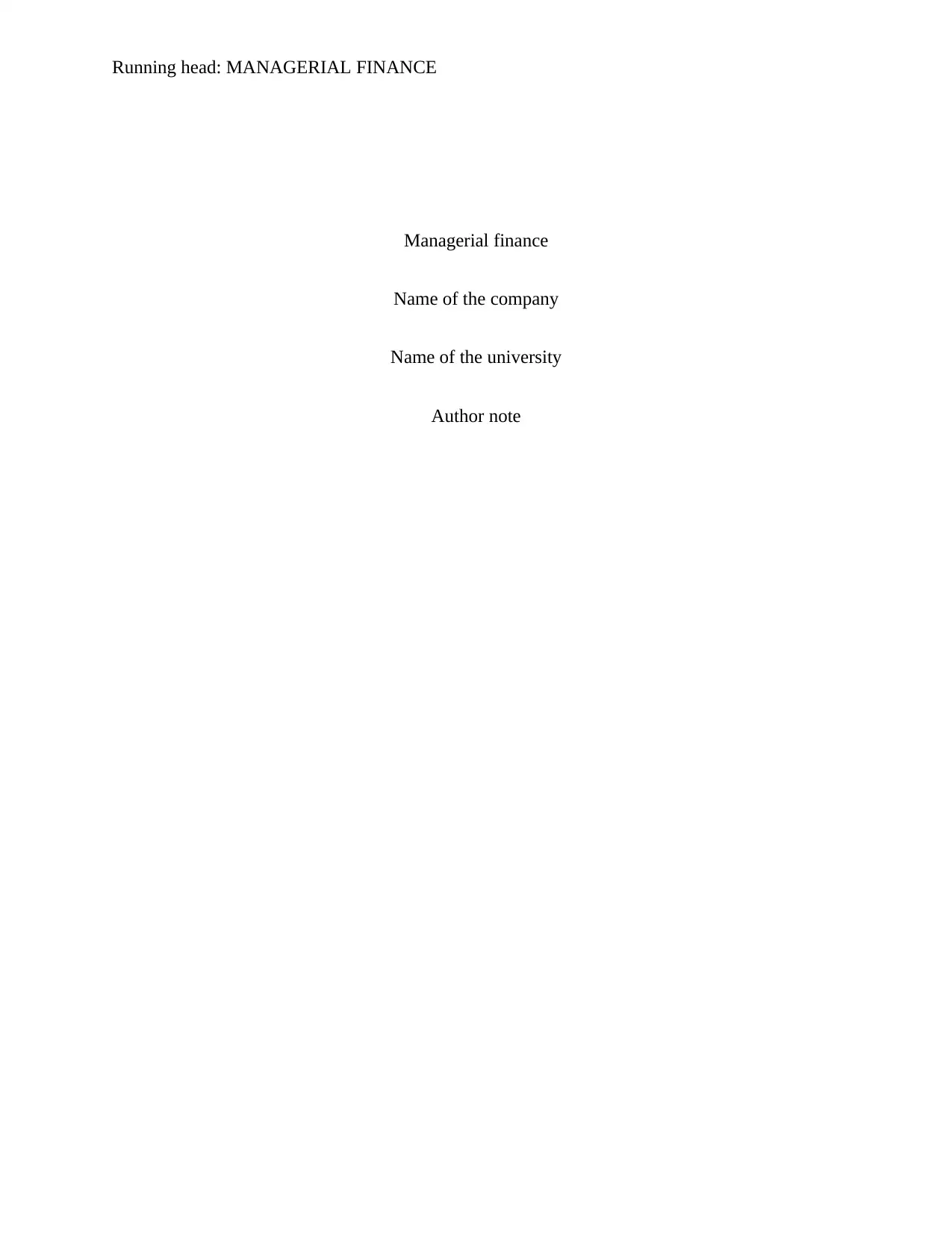
Running head: MANAGERIAL FINANCE
Managerial finance
Name of the company
Name of the university
Author note
Managerial finance
Name of the company
Name of the university
Author note
Paraphrase This Document
Need a fresh take? Get an instant paraphrase of this document with our AI Paraphraser
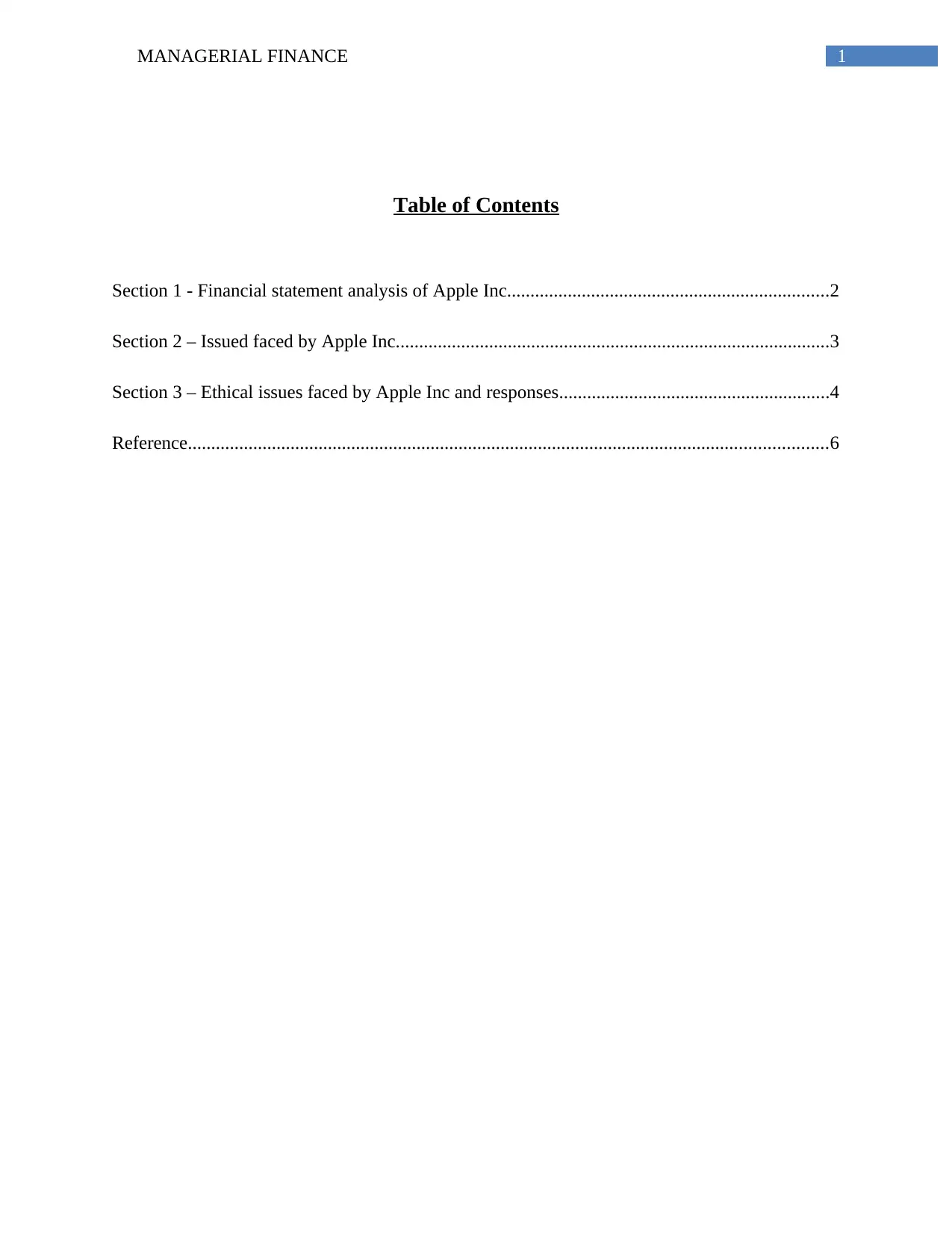
1MANAGERIAL FINANCE
Table of Contents
Section 1 - Financial statement analysis of Apple Inc.....................................................................2
Section 2 – Issued faced by Apple Inc.............................................................................................3
Section 3 – Ethical issues faced by Apple Inc and responses..........................................................4
Reference.........................................................................................................................................6
Table of Contents
Section 1 - Financial statement analysis of Apple Inc.....................................................................2
Section 2 – Issued faced by Apple Inc.............................................................................................3
Section 3 – Ethical issues faced by Apple Inc and responses..........................................................4
Reference.........................................................................................................................................6
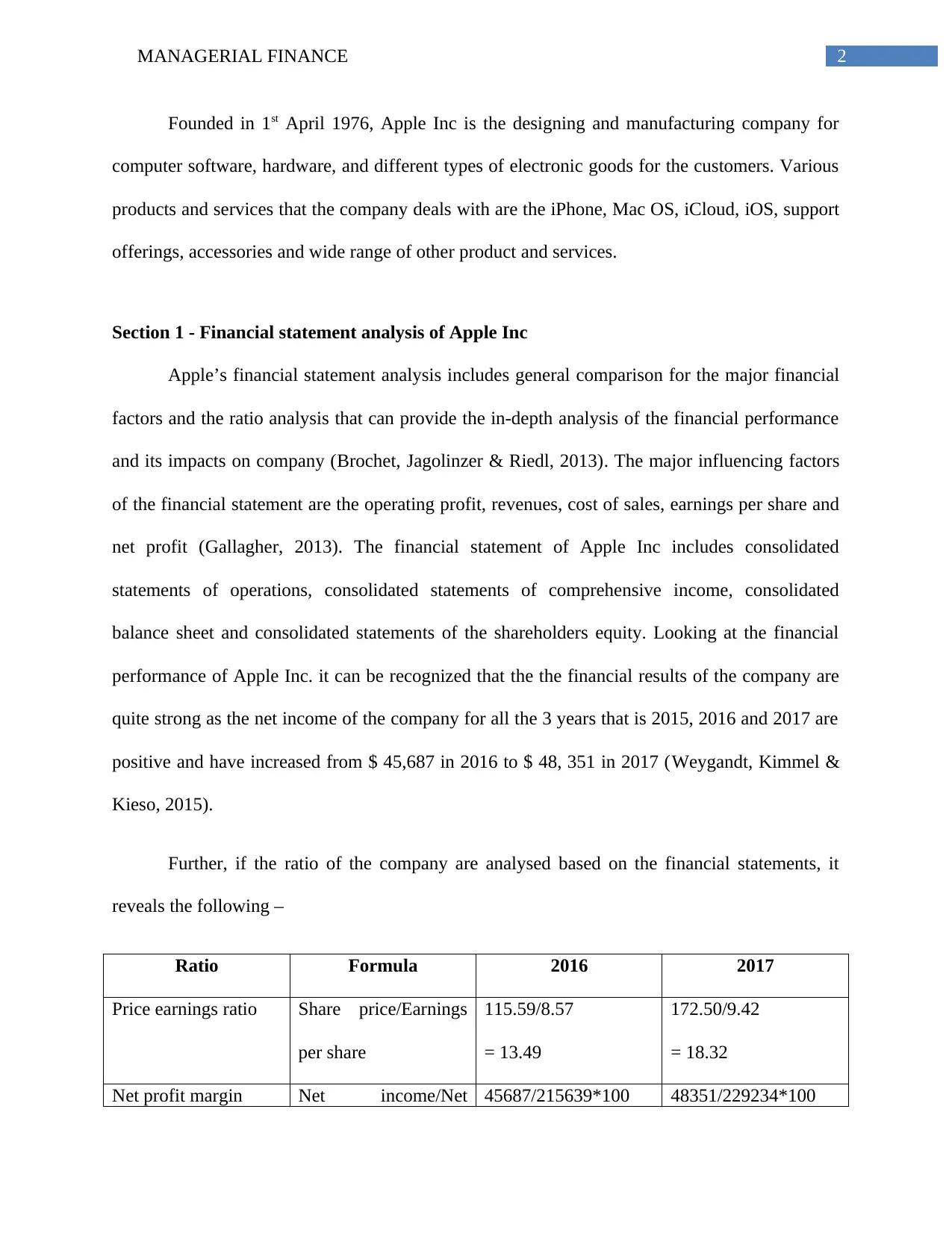
2MANAGERIAL FINANCE
Founded in 1st April 1976, Apple Inc is the designing and manufacturing company for
computer software, hardware, and different types of electronic goods for the customers. Various
products and services that the company deals with are the iPhone, Mac OS, iCloud, iOS, support
offerings, accessories and wide range of other product and services.
Section 1 - Financial statement analysis of Apple Inc
Apple’s financial statement analysis includes general comparison for the major financial
factors and the ratio analysis that can provide the in-depth analysis of the financial performance
and its impacts on company (Brochet, Jagolinzer & Riedl, 2013). The major influencing factors
of the financial statement are the operating profit, revenues, cost of sales, earnings per share and
net profit (Gallagher, 2013). The financial statement of Apple Inc includes consolidated
statements of operations, consolidated statements of comprehensive income, consolidated
balance sheet and consolidated statements of the shareholders equity. Looking at the financial
performance of Apple Inc. it can be recognized that the the financial results of the company are
quite strong as the net income of the company for all the 3 years that is 2015, 2016 and 2017 are
positive and have increased from $ 45,687 in 2016 to $ 48, 351 in 2017 (Weygandt, Kimmel &
Kieso, 2015).
Further, if the ratio of the company are analysed based on the financial statements, it
reveals the following –
Ratio Formula 2016 2017
Price earnings ratio Share price/Earnings
per share
115.59/8.57
= 13.49
172.50/9.42
= 18.32
Net profit margin Net income/Net 45687/215639*100 48351/229234*100
Founded in 1st April 1976, Apple Inc is the designing and manufacturing company for
computer software, hardware, and different types of electronic goods for the customers. Various
products and services that the company deals with are the iPhone, Mac OS, iCloud, iOS, support
offerings, accessories and wide range of other product and services.
Section 1 - Financial statement analysis of Apple Inc
Apple’s financial statement analysis includes general comparison for the major financial
factors and the ratio analysis that can provide the in-depth analysis of the financial performance
and its impacts on company (Brochet, Jagolinzer & Riedl, 2013). The major influencing factors
of the financial statement are the operating profit, revenues, cost of sales, earnings per share and
net profit (Gallagher, 2013). The financial statement of Apple Inc includes consolidated
statements of operations, consolidated statements of comprehensive income, consolidated
balance sheet and consolidated statements of the shareholders equity. Looking at the financial
performance of Apple Inc. it can be recognized that the the financial results of the company are
quite strong as the net income of the company for all the 3 years that is 2015, 2016 and 2017 are
positive and have increased from $ 45,687 in 2016 to $ 48, 351 in 2017 (Weygandt, Kimmel &
Kieso, 2015).
Further, if the ratio of the company are analysed based on the financial statements, it
reveals the following –
Ratio Formula 2016 2017
Price earnings ratio Share price/Earnings
per share
115.59/8.57
= 13.49
172.50/9.42
= 18.32
Net profit margin Net income/Net 45687/215639*100 48351/229234*100
⊘ This is a preview!⊘
Do you want full access?
Subscribe today to unlock all pages.

Trusted by 1+ million students worldwide
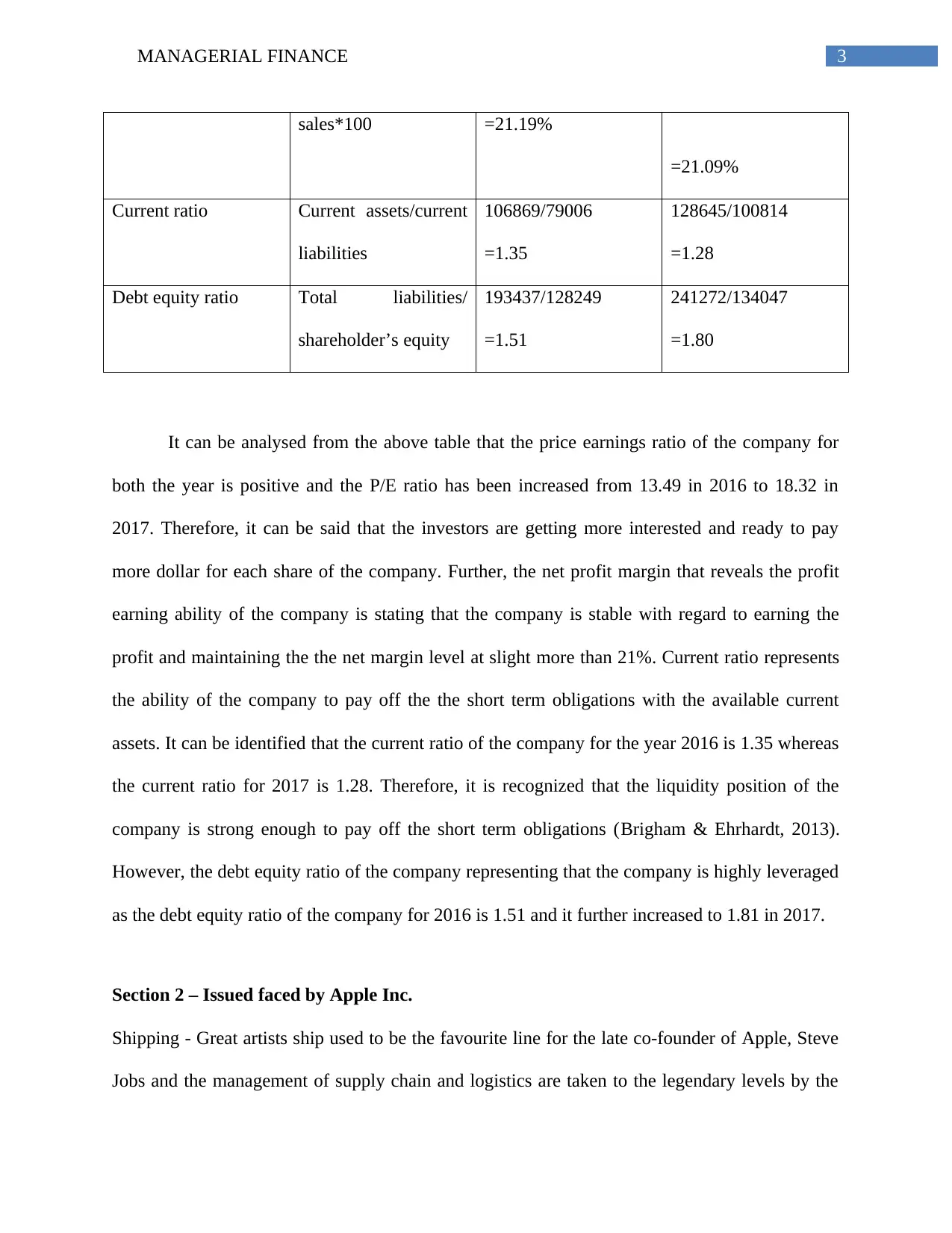
3MANAGERIAL FINANCE
sales*100 =21.19%
=21.09%
Current ratio Current assets/current
liabilities
106869/79006
=1.35
128645/100814
=1.28
Debt equity ratio Total liabilities/
shareholder’s equity
193437/128249
=1.51
241272/134047
=1.80
It can be analysed from the above table that the price earnings ratio of the company for
both the year is positive and the P/E ratio has been increased from 13.49 in 2016 to 18.32 in
2017. Therefore, it can be said that the investors are getting more interested and ready to pay
more dollar for each share of the company. Further, the net profit margin that reveals the profit
earning ability of the company is stating that the company is stable with regard to earning the
profit and maintaining the the net margin level at slight more than 21%. Current ratio represents
the ability of the company to pay off the the short term obligations with the available current
assets. It can be identified that the current ratio of the company for the year 2016 is 1.35 whereas
the current ratio for 2017 is 1.28. Therefore, it is recognized that the liquidity position of the
company is strong enough to pay off the short term obligations (Brigham & Ehrhardt, 2013).
However, the debt equity ratio of the company representing that the company is highly leveraged
as the debt equity ratio of the company for 2016 is 1.51 and it further increased to 1.81 in 2017.
Section 2 – Issued faced by Apple Inc.
Shipping - Great artists ship used to be the favourite line for the late co-founder of Apple, Steve
Jobs and the management of supply chain and logistics are taken to the legendary levels by the
sales*100 =21.19%
=21.09%
Current ratio Current assets/current
liabilities
106869/79006
=1.35
128645/100814
=1.28
Debt equity ratio Total liabilities/
shareholder’s equity
193437/128249
=1.51
241272/134047
=1.80
It can be analysed from the above table that the price earnings ratio of the company for
both the year is positive and the P/E ratio has been increased from 13.49 in 2016 to 18.32 in
2017. Therefore, it can be said that the investors are getting more interested and ready to pay
more dollar for each share of the company. Further, the net profit margin that reveals the profit
earning ability of the company is stating that the company is stable with regard to earning the
profit and maintaining the the net margin level at slight more than 21%. Current ratio represents
the ability of the company to pay off the the short term obligations with the available current
assets. It can be identified that the current ratio of the company for the year 2016 is 1.35 whereas
the current ratio for 2017 is 1.28. Therefore, it is recognized that the liquidity position of the
company is strong enough to pay off the short term obligations (Brigham & Ehrhardt, 2013).
However, the debt equity ratio of the company representing that the company is highly leveraged
as the debt equity ratio of the company for 2016 is 1.51 and it further increased to 1.81 in 2017.
Section 2 – Issued faced by Apple Inc.
Shipping - Great artists ship used to be the favourite line for the late co-founder of Apple, Steve
Jobs and the management of supply chain and logistics are taken to the legendary levels by the
Paraphrase This Document
Need a fresh take? Get an instant paraphrase of this document with our AI Paraphraser

4MANAGERIAL FINANCE
CEO of Apple, Tim Cook. However, for the last few times the company is plaguing with the
issues associated with the supply management. The reason behind this is that the company
sometimes wrongly forecasts the demand or the component constraints become higher or the
yields are lower than the expectation. Further, it happens due to last minute issues regarding the
changes in the material or process of manufacturing. Sometimes it also takes place due to issues
in priorities and resources (Palepu, Healy & Peek, 2013).
Horn effect – generally Apple earn more monies from the sales of iPhones as compared to the
sales of Mac. Further, it sells more Mac notebooks as compared to the Mac desktops. However,
the demand has been now shifted to more and more mobiles from the company. However, once
the customers start getting the substitute things from a company other than Apple, it is easier for
them to get next product from other company. Therefore, as per the horn effect, it can start
breaking apart various hard-won gains that has been earned by the company over the last
decades.
Service experience – maximum things from 2016 wasted just worrying regarding the apple being
in the behind of machine learning and artificial intelligence. However, the company was doing
both for few years and while the company was falling down, it fell just because of the service
experience (Etzioni, 2016). Therefore, it required to adopt few cultures for the traditional
hardware and software for coping up with the problem that includes public facing and high
profile VP who have service experience and whose job is to assure everything starting from Siri
to Maps to music that will be delightful to the customers (Gonzalez-Padron, 2016).
Section 3 – Ethical issues faced by Apple Inc and responses
1. Employees related issues
CEO of Apple, Tim Cook. However, for the last few times the company is plaguing with the
issues associated with the supply management. The reason behind this is that the company
sometimes wrongly forecasts the demand or the component constraints become higher or the
yields are lower than the expectation. Further, it happens due to last minute issues regarding the
changes in the material or process of manufacturing. Sometimes it also takes place due to issues
in priorities and resources (Palepu, Healy & Peek, 2013).
Horn effect – generally Apple earn more monies from the sales of iPhones as compared to the
sales of Mac. Further, it sells more Mac notebooks as compared to the Mac desktops. However,
the demand has been now shifted to more and more mobiles from the company. However, once
the customers start getting the substitute things from a company other than Apple, it is easier for
them to get next product from other company. Therefore, as per the horn effect, it can start
breaking apart various hard-won gains that has been earned by the company over the last
decades.
Service experience – maximum things from 2016 wasted just worrying regarding the apple being
in the behind of machine learning and artificial intelligence. However, the company was doing
both for few years and while the company was falling down, it fell just because of the service
experience (Etzioni, 2016). Therefore, it required to adopt few cultures for the traditional
hardware and software for coping up with the problem that includes public facing and high
profile VP who have service experience and whose job is to assure everything starting from Siri
to Maps to music that will be delightful to the customers (Gonzalez-Padron, 2016).
Section 3 – Ethical issues faced by Apple Inc and responses
1. Employees related issues
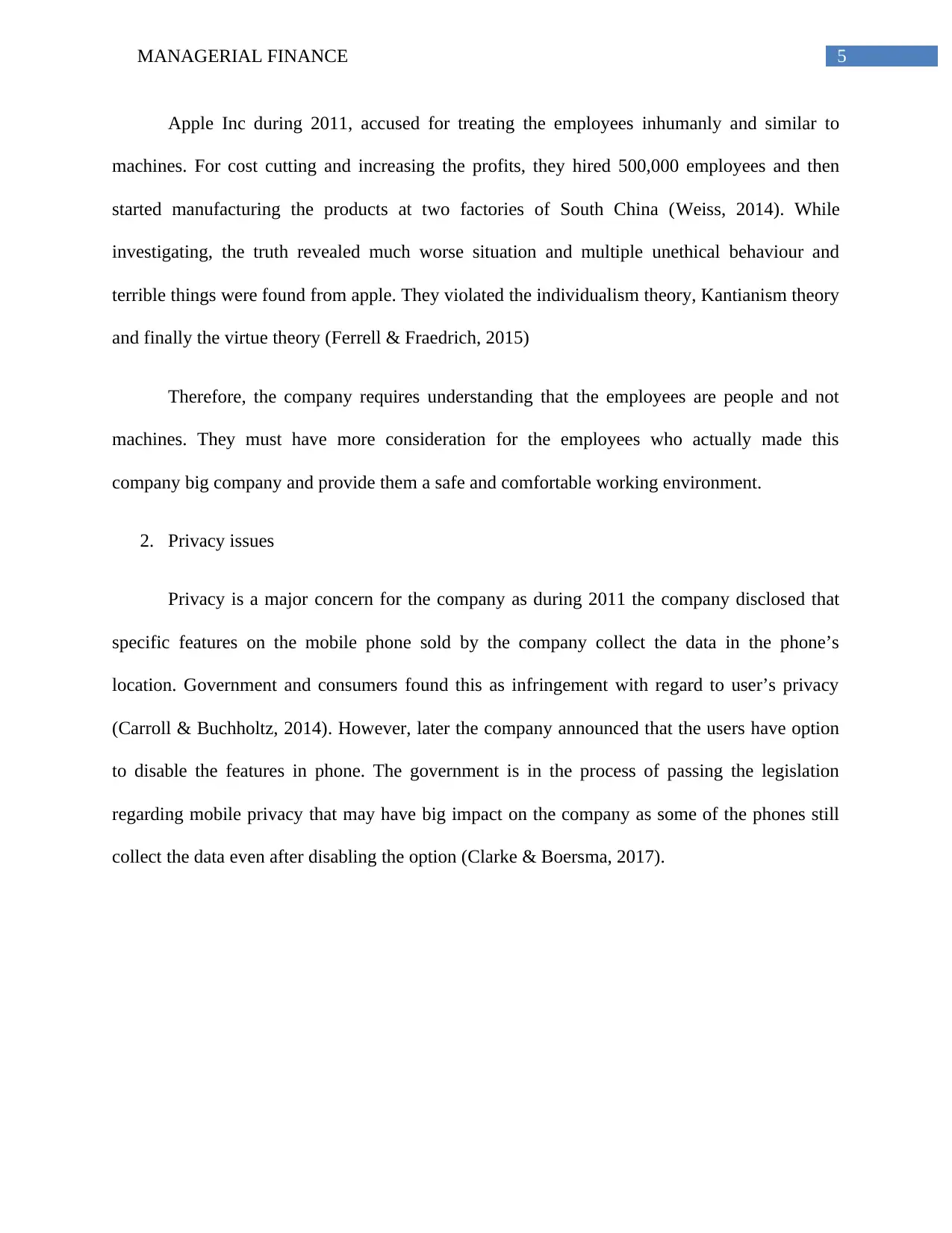
5MANAGERIAL FINANCE
Apple Inc during 2011, accused for treating the employees inhumanly and similar to
machines. For cost cutting and increasing the profits, they hired 500,000 employees and then
started manufacturing the products at two factories of South China (Weiss, 2014). While
investigating, the truth revealed much worse situation and multiple unethical behaviour and
terrible things were found from apple. They violated the individualism theory, Kantianism theory
and finally the virtue theory (Ferrell & Fraedrich, 2015)
Therefore, the company requires understanding that the employees are people and not
machines. They must have more consideration for the employees who actually made this
company big company and provide them a safe and comfortable working environment.
2. Privacy issues
Privacy is a major concern for the company as during 2011 the company disclosed that
specific features on the mobile phone sold by the company collect the data in the phone’s
location. Government and consumers found this as infringement with regard to user’s privacy
(Carroll & Buchholtz, 2014). However, later the company announced that the users have option
to disable the features in phone. The government is in the process of passing the legislation
regarding mobile privacy that may have big impact on the company as some of the phones still
collect the data even after disabling the option (Clarke & Boersma, 2017).
Apple Inc during 2011, accused for treating the employees inhumanly and similar to
machines. For cost cutting and increasing the profits, they hired 500,000 employees and then
started manufacturing the products at two factories of South China (Weiss, 2014). While
investigating, the truth revealed much worse situation and multiple unethical behaviour and
terrible things were found from apple. They violated the individualism theory, Kantianism theory
and finally the virtue theory (Ferrell & Fraedrich, 2015)
Therefore, the company requires understanding that the employees are people and not
machines. They must have more consideration for the employees who actually made this
company big company and provide them a safe and comfortable working environment.
2. Privacy issues
Privacy is a major concern for the company as during 2011 the company disclosed that
specific features on the mobile phone sold by the company collect the data in the phone’s
location. Government and consumers found this as infringement with regard to user’s privacy
(Carroll & Buchholtz, 2014). However, later the company announced that the users have option
to disable the features in phone. The government is in the process of passing the legislation
regarding mobile privacy that may have big impact on the company as some of the phones still
collect the data even after disabling the option (Clarke & Boersma, 2017).
⊘ This is a preview!⊘
Do you want full access?
Subscribe today to unlock all pages.

Trusted by 1+ million students worldwide

6MANAGERIAL FINANCE
Reference
Brigham, E. F., & Ehrhardt, M. C. (2013). Financial management: Theory & practice. Cengage
Learning.
Brochet, F., Jagolinzer, A. D., & Riedl, E. J. (2013). Mandatory IFRS adoption and financial
statement comparability. Contemporary Accounting Research, 30(4), 1373-1400.
Carroll, A., & Buchholtz, A. (2014). Business and society: Ethics, sustainability, and stakeholder
management. Nelson Education.
Clarke, T., & Boersma, M. (2017). The governance of global value chains: Unresolved human
rights, environmental and ethical dilemmas in the apple supply chain. Journal of Business
Ethics, 143(1), 111-131.
Etzioni, A. (2016). Apple: Good Business, Poor Citizen?. Journal of Business Ethics, 1-11.
Ferrell, O. C., & Fraedrich, J. (2015). Business ethics: Ethical decision making & cases. Nelson
Education.
Gallagher, T. M. (2013). Pragmatics of language: Clinical practice issues. Springer.
Gonzalez-Padron, T. L. (2016). Ethics in the Supply Chain: Follow-up processes to audit
results. Journal of Marketing Channels, 23(1-2), 22-33.
Palepu, K. G., Healy, P. M., & Peek, E. (2013). Business analysis and valuation: IFRS edition.
Cengage Learning.
Reference
Brigham, E. F., & Ehrhardt, M. C. (2013). Financial management: Theory & practice. Cengage
Learning.
Brochet, F., Jagolinzer, A. D., & Riedl, E. J. (2013). Mandatory IFRS adoption and financial
statement comparability. Contemporary Accounting Research, 30(4), 1373-1400.
Carroll, A., & Buchholtz, A. (2014). Business and society: Ethics, sustainability, and stakeholder
management. Nelson Education.
Clarke, T., & Boersma, M. (2017). The governance of global value chains: Unresolved human
rights, environmental and ethical dilemmas in the apple supply chain. Journal of Business
Ethics, 143(1), 111-131.
Etzioni, A. (2016). Apple: Good Business, Poor Citizen?. Journal of Business Ethics, 1-11.
Ferrell, O. C., & Fraedrich, J. (2015). Business ethics: Ethical decision making & cases. Nelson
Education.
Gallagher, T. M. (2013). Pragmatics of language: Clinical practice issues. Springer.
Gonzalez-Padron, T. L. (2016). Ethics in the Supply Chain: Follow-up processes to audit
results. Journal of Marketing Channels, 23(1-2), 22-33.
Palepu, K. G., Healy, P. M., & Peek, E. (2013). Business analysis and valuation: IFRS edition.
Cengage Learning.
Paraphrase This Document
Need a fresh take? Get an instant paraphrase of this document with our AI Paraphraser

7MANAGERIAL FINANCE
Weiss, J. W. (2014). Business ethics: A stakeholder and issues management approach. Berrett-
Koehler Publishers.
Weygandt, J. J., Kimmel, P. D., & Kieso, D. E. (2015). Financial & Managerial Accounting.
John Wiley & Sons.
Weiss, J. W. (2014). Business ethics: A stakeholder and issues management approach. Berrett-
Koehler Publishers.
Weygandt, J. J., Kimmel, P. D., & Kieso, D. E. (2015). Financial & Managerial Accounting.
John Wiley & Sons.
1 out of 8
Related Documents
Your All-in-One AI-Powered Toolkit for Academic Success.
+13062052269
info@desklib.com
Available 24*7 on WhatsApp / Email
![[object Object]](/_next/static/media/star-bottom.7253800d.svg)
Unlock your academic potential
Copyright © 2020–2025 A2Z Services. All Rights Reserved. Developed and managed by ZUCOL.




